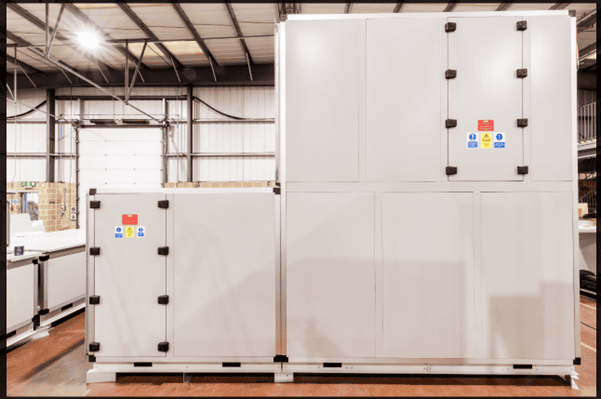In an HVAC industry where performance expectations and cost pressures often clash, getting AHU thermal classifications right can be the difference between a well-optimised system and an unnecessarily expensive one. At ECE UK, we understand that in an increasingly competitive landscape, the importance of precise thermal classifications cannot be overstated.
As a leading manufacturer of air handling units, we face a pivotal question: how essential are classifications such as T2/TB2 thermal classification (as shown in Figure 1) for healthcare HVAC design, compared to T4/TB4 AHU specification (as shown in Figure 2) for commercial and retail environments?
Understanding the framework of BS EN 1886:2007 for thermal performance ratings provides valuable insight into how the difference between T2/TB2 and T4/TB4 AHUs impacts system performance, compliance, and cost-efficiency.
To ensure continued performance, don’t forget to explore our services for air handling unit maintenance and air handling unit condition reports, which support optimal operation throughout the lifecycle.
Our commitment to engineering precision is backed by our management systems, designed to uphold the highest standards across all sectors.
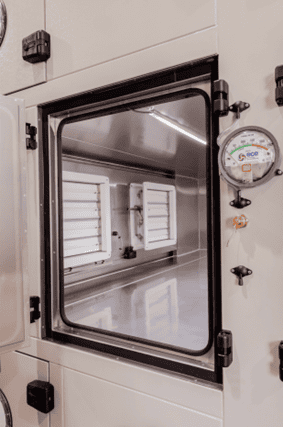
Figure 1: T2/TB2 Framework
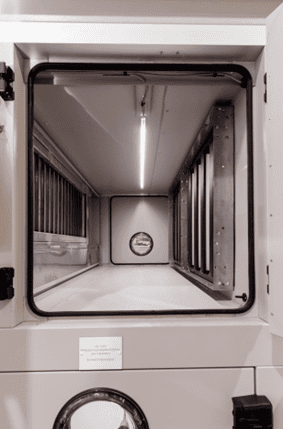
Figure 2: T4/TB4 Framework
Are we over specifying AHUs?
In healthcare projects, such as those adhering to HTM 03-01 guidelines, the pressure to specify T2/TB2 thermal classification is justified by the need for stringent air quality and environmental control. These standards serve as safeguards, ensuring that air handling units meet the rigorous demands for indoor air quality and temperature regulation crucial for patient care. However, over-specifying T2/TB2 can inflate costs and create unnecessarily complex systems that may exceed actual performance needs.
In contrast, when it comes to commercial and retail environments, the use of T4/TB4 AHU specifications can yield cost-effective solutions without compromising system performance. These specifications allow for flexibility, reducing unnecessary expenditure while maintaining acceptable air quality standards — particularly in settings that may not require the same level of scrutiny as healthcare HVAC design.
To ensure ongoing efficiency, consider scheduling an air handling unit condition report to assess whether current classifications are aligned with your operational requirements.
What do T-class ratings really mean?
Thermal transmittance in HVAC, rated from T1 to T5 under the framework of BS EN 1886:2007, quantifies heat transfer through the AHU casing. A T1 rating signifies exceptional efficiency in minimising heat transfer, while a T5 represents the highest level of thermal loss (as shown in Figure 3). By delineating these classifications, BS EN 1886:2007 offers a structured way to assess the suitability of air handling units across different environments.
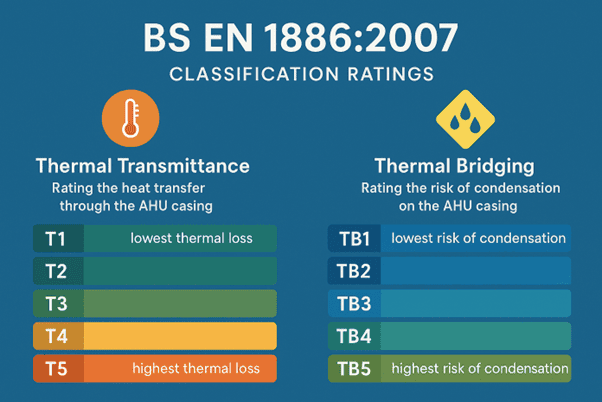
Figure 3: T-class ratings
In healthcare HVAC design, choosing T2 often seems prudent, aligning with the stringent demands for temperature maintenance and air-quality control. However, in commercial HVAC applications, T4/TB4 AHU specification can be effectively deployed to optimise performance while remaining budget conscious.
Our commitment at ECE UK is to provide AHU thermal classifications and engineering solutions tailored to fit the operational realities and environmental conditions specific to each project.
Why do TB-class ratings matter?
A TB1 rating indicates minimal risk of condensation, while TB2 acknowledges only a very small increase. Given the intense focus on sterilisation and air quality in healthcare HVAC design, TB2 ratings are not just common but essential for compliance with air handling unit requirements for hospitals.
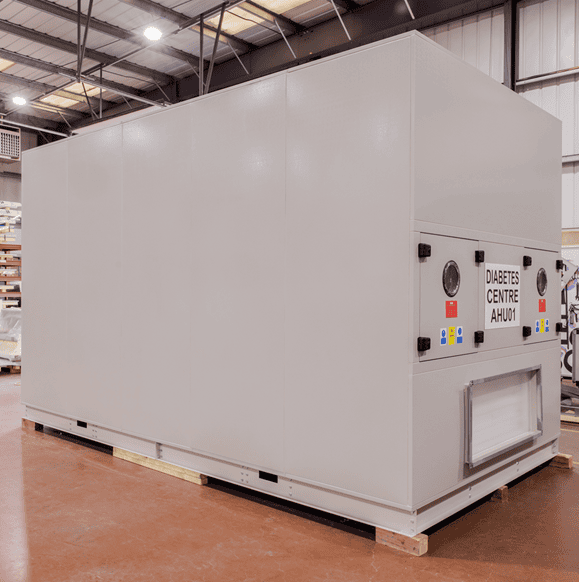
Figure 4: Diabetes centre AHU
In contrast, a T4/TB4 classification may suffice in commercial and retail environments, where the operational conditions allow for more leniency. Misapplying T2/TB2 thermal classification in these cases can complicate specifications unnecessarily and inflate project costs without enhancing performance.
Where high specs hurt more than help
The prevailing trend toward specifying T2 and TB2 across various projects raises concerns akin to the ubiquitous approach of selecting neutral wall colours in design. Though these classifications may indicate a desire for high air handling unit efficiency, they often lack the contextual justification required for optimal application. Such practices not only limit competition among suppliers but also risk inflating project budgets, particularly in commercial and retail HVAC cost optimisation scenarios.
To avoid misapplication, clients should consider aligning their specifications with actual performance needs. Our management systems are designed to support smarter specification strategies that reflect operational reality — not assumption.
Putting classifications to the test
To ensure our classifications and product performance align with industry standards, ECE UK has now worked with BSRIA (Building Services Research and Information Association) to conduct rigorous tests. Through comprehensive testing based on the BS EN 1886:2007 standards, we measure the performance of both T2/TB2 thermal classification and T4/TB4 AHU specification designs under a variety of controlled conditions.
Our testing results emphasise that while T2/TB2 configurations are seen as necessary in healthcare settings, the T4/TB4 specifications perform admirably in thermal classification HVAC systems in retail and commercial contexts. (as shown in Figure 5) For instance, testing has demonstrated that T4/TB4 units maintain effective humidity control, air handling unit performance, and without condensation under typical operating conditions — highlighting their suitability without the associated costs of higher classifications.
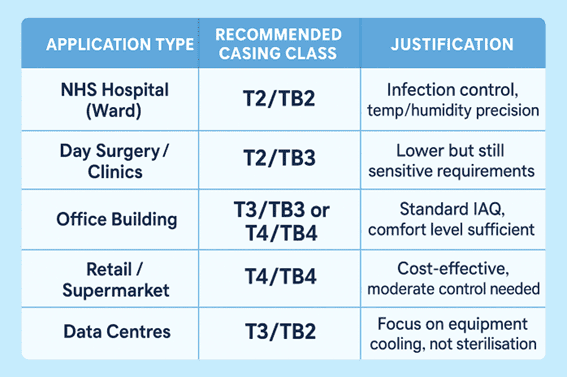
Figure 5: T2/TB2 thermal classification and T4/TB4 AHU specification
Matching classifications to reality
Ultimately, the key takeaway is that understanding thermal classifications, such as T2/TB2 for healthcare projects and T4/TB4 for commercial and retail applications, is essential for optimising both system performance and budget. By carefully evaluating when and where to apply these specifications, we can deliver solutions that meet and exceed client expectations while remaining cost-effective.
At ECE UK, our commitment is to provide efficient, high-quality air-handling solutions tailored to the unique demands of each project. By harnessing the guidance of BS EN 1886:2007 and conducting thorough testing with BSRIA, we ensure our products are not only innovative but also practical and aligned with real-world applications.
As we continue to navigate the complexities of HVAC system design, our focus remains on achieving the right balance between performance, cost, and suitability for every environment—be it in healthcare, commercial, or retail settings.
FAQS: Navigating thermal classifications in healthcare and commercial projects
What are thermal classifications in building projects?
In this document we refer to thermal classifications in BS EN 1886 that relates to air handling units that support building projects. BS EN 1886 doesn’t cover the buildings themselves and just refers to an AHU.
Why are thermal classifications important in healthcare and commercial buildings?
Proper thermal classification ensures comfort, safety, and energy efficiency. In healthcare, it is critical for patient well-being and infection control, while in commercial projects, it supports occupant comfort and operational cost savings.
How do thermal requirements differ between healthcare and commercial projects?
Healthcare facilities often have stricter thermal requirements due to the need for infection control, sensitive equipment, and patient recovery. Commercial buildings typically focus on occupant comfort and energy efficiency, with more flexibility in temperature and humidity ranges.
What factors influence thermal classification decisions?
Key factors include the building’s purpose, occupancy patterns, equipment loads, regulatory standards, and specific functional needs of each space (e.g., operating rooms vs. office spaces).
How do regulations impact thermal classifications?
Both healthcare and commercial projects must comply with building codes and standards that dictate minimum thermal performance, ventilation rates, and environmental controls to ensure safety and efficiency.
What are common challenges in navigating thermal classifications?
Challenges include balancing energy efficiency with occupant comfort, integrating new technologies, addressing diverse space requirements, and ensuring compliance with evolving regulations.
